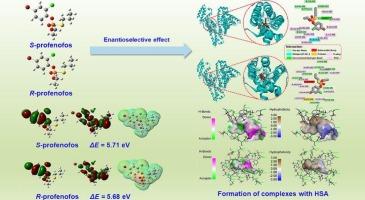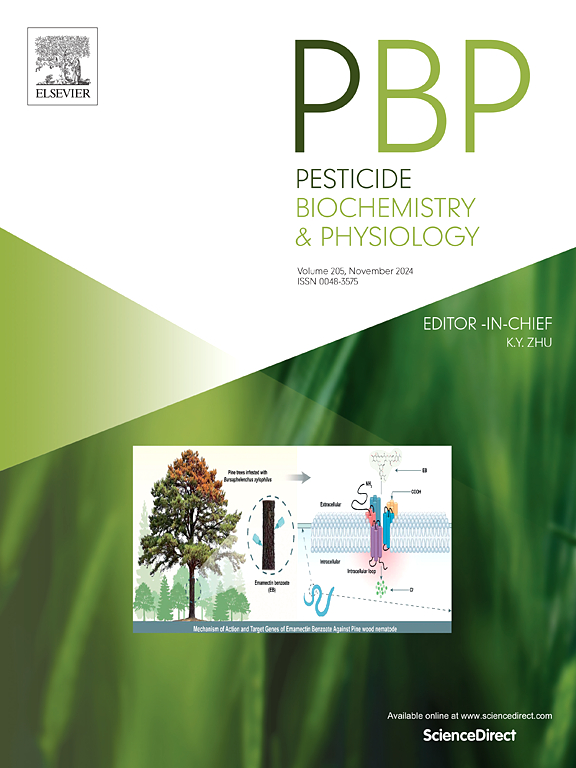Enantioselective effects of chiral profenofos on the conformation for human serum albumin
IF 4.2
1区 农林科学
Q2 BIOCHEMISTRY & MOLECULAR BIOLOGY
引用次数: 0
Abstract
Profenofos, as a typical chiral organophosphorus pesticide, can cause various environmental problems and even endanger human health when used in excess. The toxicity of chiral profenofos was investigated through multispectral analysis, molecular docking, and density functional theory (DFT), employing human serum albumin (HSA) as the model protein. Fluorescence titration and lifetime measurements demonstrated that the interaction between chiral profenofos and HSA involves static quenching. Chiral profenofos forms a 1:1 complex with HSA at site II (subdomain IIIA), primarily driven by hydrophobic interactions and hydrogen bonds. Notably, the binding efficacy diminishes as temperature increases. Spectroscopic analyses confirm that chiral profenofos alters the microenvironment and structure of HSA, with the R-enantiomer exerting a greater impact than the S-enantiomer. Consequently, the toxicological implications of the R-profenofos is significantly more pronounced. Investigating the molecular-level toxic effects of chiral pesticides enhances the thoroughness of pesticide assessments, aids in understanding their distribution, metabolism, and associated risks, and facilitates the development of mitigation strategies.

手性丙溴磷对人血清白蛋白构象的对映选择性影响
丙溴磷是一种典型的手性有机磷农药,过量使用会引发各种环境问题,甚至危害人体健康。本研究以人血清白蛋白(HSA)为模型蛋白,通过多光谱分析、分子对接和密度泛函理论(DFT)研究了手性丙溴磷的毒性。荧光滴定和寿命测量结果表明,手性丙溴磷与 HSA 之间的相互作用涉及静态淬灭。手性丙溴磷在位点 II(亚域 IIIA)与 HSA 形成 1:1 的复合物,主要由疏水相互作用和氢键驱动。值得注意的是,随着温度的升高,结合效力会降低。光谱分析证实,手性丙溴磷改变了 HSA 的微环境和结构,R-对映体比 S-对映体产生的影响更大。因此,R-丙溴磷的毒理学影响要明显得多。调查手性农药分子水平的毒性效应可提高农药评估的彻底性,有助于了解其分布、代谢和相关风险,并促进制定缓解策略。
本文章由计算机程序翻译,如有差异,请以英文原文为准。
求助全文
约1分钟内获得全文
求助全文
来源期刊
CiteScore
7.00
自引率
8.50%
发文量
238
审稿时长
4.2 months
期刊介绍:
Pesticide Biochemistry and Physiology publishes original scientific articles pertaining to the mode of action of plant protection agents such as insecticides, fungicides, herbicides, and similar compounds, including nonlethal pest control agents, biosynthesis of pheromones, hormones, and plant resistance agents. Manuscripts may include a biochemical, physiological, or molecular study for an understanding of comparative toxicology or selective toxicity of both target and nontarget organisms. Particular interest will be given to studies on the molecular biology of pest control, toxicology, and pesticide resistance.
Research Areas Emphasized Include the Biochemistry and Physiology of:
• Comparative toxicity
• Mode of action
• Pathophysiology
• Plant growth regulators
• Resistance
• Other effects of pesticides on both parasites and hosts.
文献相关原料
公司名称
产品信息
百灵威
Tris-HCl
¥10.00~¥288406.51

 求助内容:
求助内容: 应助结果提醒方式:
应助结果提醒方式:


